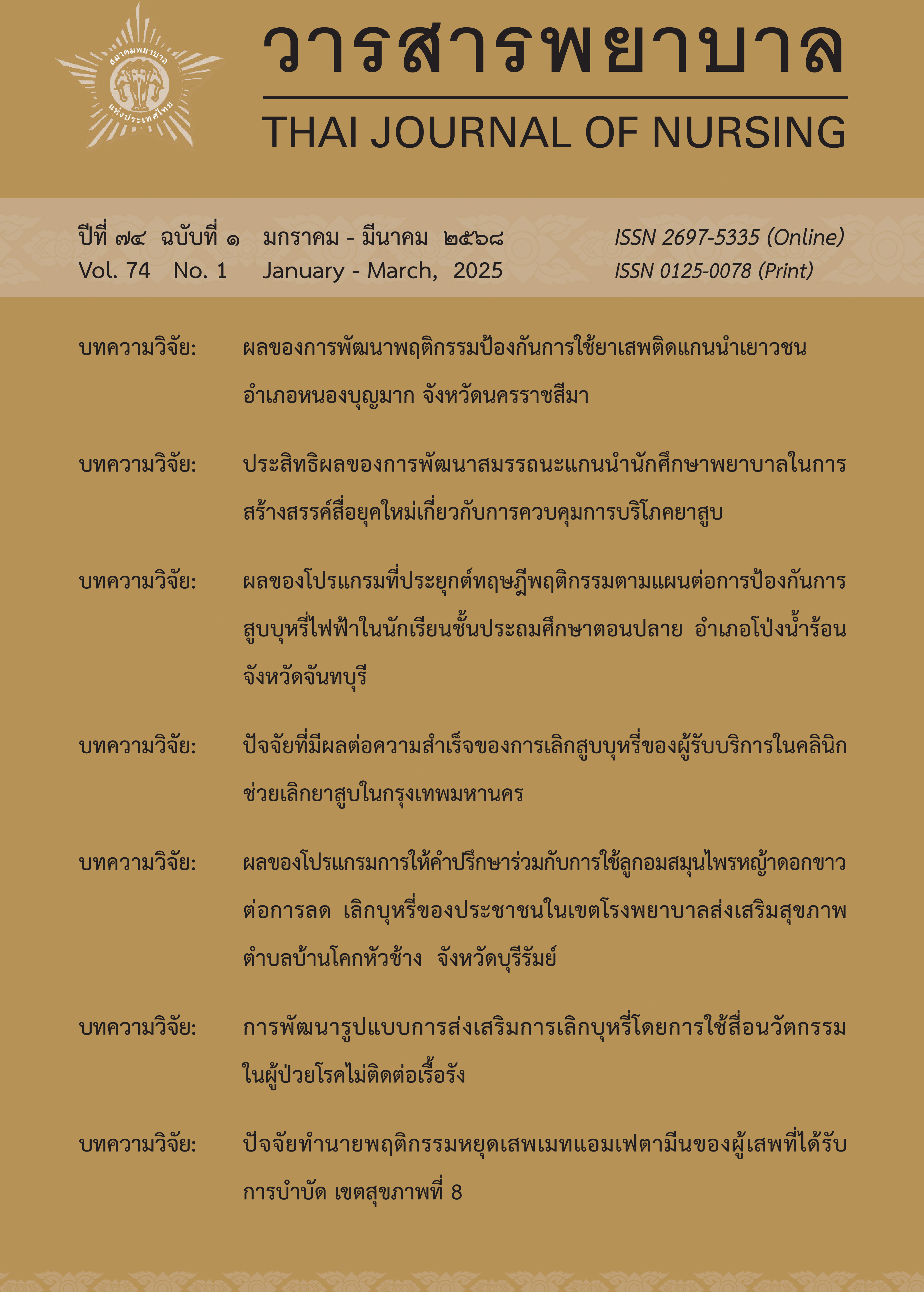Predictive factors of methamphetamine cessation behavior of methamphetamine addicts with completed treatment, the 8th Health Region
Main Article Content
Abstract
This predictive research aimed to study 1) the methamphetamine cessation behavior among drug users who completed treatment in the 8th Health Region and 2) the influence of predictive factors on methamphetamine cessation behavior among drug users who completed treatment. The sample consisted of 222 methamphetamine users who completed treatment at Thanyarak Hospital, Udon Thani. The research instrument was a questionnaire consisting of 7 sections. Content validity indexes of the 2nd to 7th questionnaire sections were between 0.86-1.00, Cronbach's alpha coefficients were between 0.71-0.97, Confirmatory factor analysis were between 0.82-0.97. The data analysis statistics were structural equation modeling. The results illustrated that 1) the methamphetamine cessation behavior of drug users who completed treatment in the 8th Health Region was at a good level, and 2) the structural equation model of the factors predicting methamphetamine cessation behavior was consistent with the empirical data. The thought control behavior about methamphetamine directly influenced methamphetamine cessation behavior which accounted for 71.9 percent. The factors indirectly influencing methamphetamine cessation behavior through thought control behavior about methamphetamine use were family acceptance, thoughts about methamphetamine, motivation to quit methamphetamine, and social acceptance. Drug access has an indirect influence on methamphetamine cessation behavior through thoughts about methamphetamine.
Article Details

This work is licensed under a Creative Commons Attribution-NonCommercial-NoDerivatives 4.0 International License.
References
กระทรวงสาธารณสุข กรมสุขภาพจิต. (2563). คู่มือระบบการดูแลผู้ป่วยจิตเวชที่มีความเสี่ยงสูงต่อการก่อความรุนแรงสำหรับสถาบัน/โรงพยาบาล สังกัดกรมสุขภาพจิต. พรอสเพอรัสพลัส.
กระทรวงสาธารณสุข สำนักงานเลขานุการคณะกรรมการบำบัดรักษาและฟื้นฟูผู้ติดยาเสพติด. (2567, 15 กุมภาพันธ์). รายงานผลการดำเนินการบำบัดรักษาฟื้นฟูผู้ติดยาเสพติด รายสัปดาห์ ตั้งแต่วันที่ 4 - 10 กุมภาพันธ์ 2567. https://ncmc.moph.go.th/home/index/detail/30573
กัญญา ภู่ระหงษ์. (2561). ปัจจัยที่มีผลต่อการเสพซ้ำของผู้ติดยาเสพติดในเขตจังหวัดปทุมธานี. วารสารพยาบาลสาธารณสุข, 32(2), 23-40.
จุไรพร สัมพุทธานนท์ และ จินตนา ยูนิพันธุ์. (2561). ปัจจัยที่สัมพันธ์กับการรับรู้ความสามารถของตนเองในการป้องกันการเสพแอมเฟตามีนซ้ำของวัยรุ่นชายสถานบำบัดยาเสพติดของรัฐ. วารสารการพยาบาลและการดูแลสุขภาพ, 36(1), 6-14.
โรงพยาบาลธัญญารักษ์อุดรธานี. (2566). รายงานการบำบัดรักษาและฟื้นฟูผู้ติดยาเสพติดโรงพยาบาลธัญญารักษ์อุดรธานี. โรงพยาบาลธัญญารักษ์อุดรธานี.
ศิริลักษณ์ ปัญญา, เสาวลักษณ์ ทาแจ้ง, นภาจันทร์ ชาปลิก, สุกัญญา กาญจนบัตร, และจริยา มงคลสวัสดิ์. (2564). ความสัมพันธ์ระหว่างปัจจัยส่วนบุคคล ปัจจัยจิตสังคม และปัจจัยสิ่งแวดล้อมกับการกลับมาเสพยาซ้ำของผู้กลับไปเสพแอมเฟตามีนซ้ำในโรงพยาบาลธัญญารักษ์. พยาบาลสาร, 43(2), 273-281.
ศุภฤกษ์ นาคดิลก. (2563). อุบัติการณ์ของผู้ป่วยที่ใช้สารเมทแอมเฟตามีนซ้ำในสถาบันบำบัดรักษาและฟื้นฟูผู้ติดยาเสพติดแห่งชาติบรมราชชนนี (สบยช.). วารสารวิชาการเสพติด, 6(1), 47-58.
สมศักดิ์ เพียววงศ์. (2560). รูปแบบความสัมพันธ์ของปัจจัยที่ส่งผลต่อความสำเร็จในการป้องกันการเสพยา เสพติดซ้ำของกลุ่มผู้ผ่านการบำบัดฟื้นฟูสมรรถภาพผู้ติดยาเสพติดในพื้นที่กรุงเทพมหานคร. วารสารช่อพะยอม, 28(2), 120-135.
อรรถพล ยิ้มยรรยง และ เพ็ญนภา แดงด้อมยุทธ์ (2564). ผลของการบำบัดทางความคิดและพฤติกรรมอย่างย่อโดยครอบครัวมีส่วนร่วมต่อการเสพแอมเฟตามีนของวัยรุ่นเสพติดแอมเฟตามีนระยะฟื้นฟู. วารสารวิทยาลัยพยาบาลบรมราชชนนี อุตรดิตถ์, 13(1), 71-83.
อัครวัฒน์ เพียวพงภควัต. (2563). ปัจจัยทำนายการสนับสนุนทางสังคมของครอบครัวและชุมชนกับการเลิกเสพสารเสพติดประเภทเมทแอมเฟตามีน โรงพยาบาลหนองกี่ จังหวัดบุรีรัมย์. วารสารศูนย์อนามัยที่ 9: วารสารส่งเสริมสุขภาพและอนามัยสิ่งแวดล้อม, 14(33), 22-34.
อับดุลคอลิก อัรรอฮีมีย์, ฐานิดาภัทฐ์ แสงทอง, จิรัชยา เจียวก๊ก, และสวัสดิ์ ไหลภาภรณ์. (2565). การป้องกันการเสพยาเสพติดซ้ำด้วยตนเอง: กรณีศึกษา ผู้ผ่านการบำบัดรักษาอาการติดสารเสพติดในพื้นที่จังหวัดปัตตานี. วารสารการพัฒนาชุมชนและคุณภาพชีวิต, 10(3), 345-357.
Hair, J. F., Black, W. C., Babin, B. J., & Anderson, R. E. (2014). Multivariate data analysis (7 th.ed.). Pearson Education.
Kline, R. B. (2005). Principles and practice of structural equation modeling. Guilford Press.
United Nations Office on Drugs and Crime. (2022). World drug report 2022: Booklet 1 Executive summary policy implication. United Nations.


